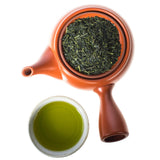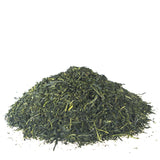A young monk once asked the wise tea master Lao Cha:
– Sensei, how can we make green tea not only fresh and healthy but also delicately sweet?
– In the early Spring, when the tea bushes start to wake up from their long winter sleep and the first tea leaves begin to appear, make sure to shade them from the sun. Then, the plant will not waste its energy on producing bitter sunblock for its leaves. Instead, it will concentrate on making sweet theanine. The tea made from these very leaves will be gentle and sweet. This tea will be worthy of the Gods. You will call it Gyokuro.
Gyokuro is rightfully regarded as the highest grade of Japanese tea. Gyokuro tea is made only with the first flush leaves, and the tea bushes are shaded from direct sunlight for about 20 days before harvesting. Shading makes the tea plant stack on L-theanine. It is an amino acid that gives Gyokuro tea leaves their sweetness. Afterward, the leaves are immediately steamed, dried, and carefully rolled into distinctive shapes resembling pine needles. The tea's unique processing results in a sweet, savory flavor and fresh, flowery-green aroma.
Our Dento Hon Gyokuro of Saemidori cultivar comes from Yame, Fukuoka prefecture. It is amazingly sweet, extremely rich in umami. This rare tea is hand-picked from the sweet Saemidori cultivar at the end of May. Its scent is refreshing, with next to no bitterness. This Gyokuro possesses incredible umami that will leave a round and rich feeling on your palate. After the first brew at low temperature, the leaves can be easily brewed up to three times, like sencha. Packed with amino acids and boasting a beautiful color, you can enjoy this premium tea in the late morning or early afternoon for an incredible energy boost. An extraordinary example of the excellence of Yame tea masters and one of the jewels of Koga Cha Gyo.

Shaded tea bushes
The best plantations in Fukuoka prefecture are indeed in the Yame area. Morning mists and river fogs are very frequent. Curtains of fog wrap green tea plantations, properly blocking sunlight. It makes the tea leaves more tender and sweeter. In addition, Yame enjoys a vast temperature difference from day to night.
Watch a video about Gyokuro
Watch a video on how to brew Gyokuro Tea
![]() 135℉ / 55℃ for the first infusion; 170ºF / 75ºC for subsequent infusions
135℉ / 55℃ for the first infusion; 170ºF / 75ºC for subsequent infusions
![]() 1g per 30ml
1g per 30ml
![]() 4 min for the first infusion; then flush infusion, then 30 seconds infusion
4 min for the first infusion; then flush infusion, then 30 seconds infusion



